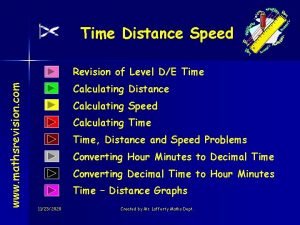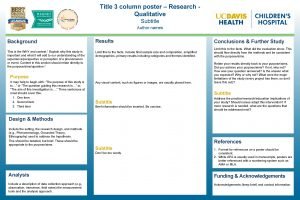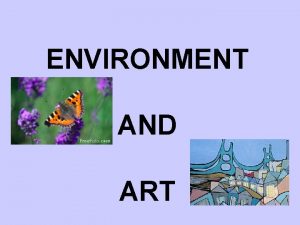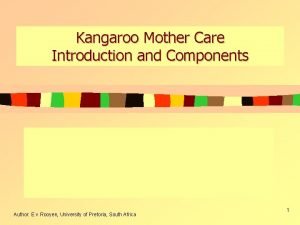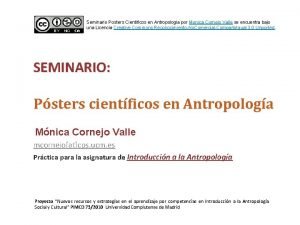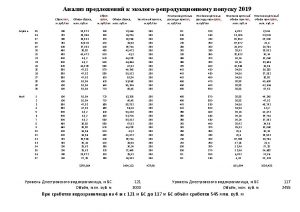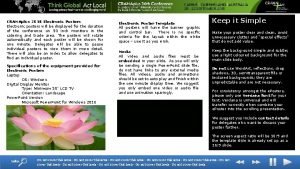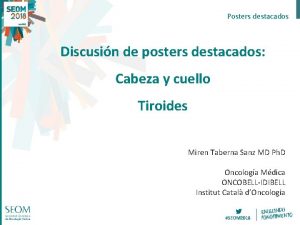Warm Up Cycle Posters 10 mins 1 min


























- Slides: 26

Warm Up `

Cycle Posters • 10 mins! • 1 min presentations each

Objective of the day Analyze how events and processes during ecological succession can change populations and species diversity.

Homework Write definitions for: ecology habitat community ecosystem abiotic factor biodiversity pioneer species succession primary succession secondary succession Ecological Succession ws Quiz Mon/Tues

Concept: Disturbance influences species diversity and composition • Decades ago, most ecologists favored the view that communities are in a state of equilibrium • Recent evidence of change has led to a nonequilibrium model, which describes communities as constantly changing after being buffeted by disturbances (such as fire) Yellow stone national park- 1988 (a) Soon after fire (b) One year after fire

Ecological Succession • Ecological succession is the sequence of community and ecosystem changes (colonized by a variety of species, gradually replaced by other species) after a disturbance: volcanic eruption or a glacier, strip away all the vegetation. • Primary succession occurs where no soil exists (lifeless area) when succession begins. Autotrophic and heterotrophic prokaryotes and protists. Lichens and moss will first colonize the land when soil develops gradually. Then grasses, shrubs, trees will sprout. • Secondary succession begins in an area where soil remains after a disturbance. Recolonization starts with herbaceous species. • Early-arriving species and later-arriving species may be linked in one of three processes: – Early arrivals may facilitate appearance of later species by making the environment favorable – They may inhibit establishment of later species – They may tolerate later species but have no impact on their establishment


Human Disturbance • Humans have the greatest impact on biological communities worldwide • Human disturbance to communities usually reduces species diversity • Humans also prevent some naturally occurring disturbances, which can be important to community structure • Logging and clearing for urban development, mining, farming, deep sea trawlers.

Changes in Ecosystems: Ecological Succession

What is Ecological Succession? • Make up of a community changes over time. • Can be primary or secondary • The gradual replacement of one plant community by another through natural processes over time

Primary Succession • Begins in a place without any soil: » Sides of volcanoes » Landslides » Flooding • First, lichens that do not need soil to survive grow on rocks • Next, mosses grow to hold newly made soil • Known as PIONEER SPECIES

Pioneer Species Lichens break down rock to form soil. Low, growing moss plants trap moisture and prevent soil erosion

Primary Succession • Soil starts to form as lichens and the forces of weather and erosion help break down rocks into smaller pieces • When lichens die, they decompose, adding small amounts of organic matter to the rock to make soil

Primary Sucession • Purpose to build and rebuild soil.


Primary Succession • Simple plants like mosses and ferns can grow in the new soil

Primary Succession • The simple plants die, adding more organic material (nutrients to the soil) • The soil layer thickens, and grasses, wildflowers, and other plants begin to take over

Primary Succession • These plants die, and they add more nutrients to the soil • Shrubs and trees can survive now

Primary Succession • Insects, small birds, and mammals have begun to move into the area • What was once bare rock, now supports a variety of life

Secondary Succession • Begins in a place that already has soil and was once the home of living organisms • Occurs faster and has different pioneer species than primary succession • Example: after forest fires





Climax Community • A stable group of plants and animals that is the end result of the succession process • Does not always mean big trees – Grasses in prairies – Cacti in deserts

 Mins to hrs
Mins to hrs 1 hour and 1 minute
1 hour and 1 minute 65 mins
65 mins Bandwagon propaganda ww2
Bandwagon propaganda ww2 Posters class 11
Posters class 11 3 column poster
3 column poster Comprehension strategies posters
Comprehension strategies posters Vetenskapliga posters
Vetenskapliga posters Advantages of posters
Advantages of posters Alphonse mucha advertising posters
Alphonse mucha advertising posters Codes and conventions of film posters
Codes and conventions of film posters Media studies poster
Media studies poster Hundertwasser environmental posters
Hundertwasser environmental posters Wpi mqp posters
Wpi mqp posters Kangaroo mother care posters
Kangaroo mother care posters How are written codes used in each of these posters
How are written codes used in each of these posters Progressive era posters
Progressive era posters Functional skills posters
Functional skills posters Pwim posters
Pwim posters Kmc position image
Kmc position image Mathematical habits of mind posters
Mathematical habits of mind posters Conventions of film noir
Conventions of film noir Des posters scientifiques efficaces
Des posters scientifiques efficaces 12 powerful words posters
12 powerful words posters Iddsi posters
Iddsi posters Iew posters
Iew posters Posters cientificos ejemplos
Posters cientificos ejemplos
